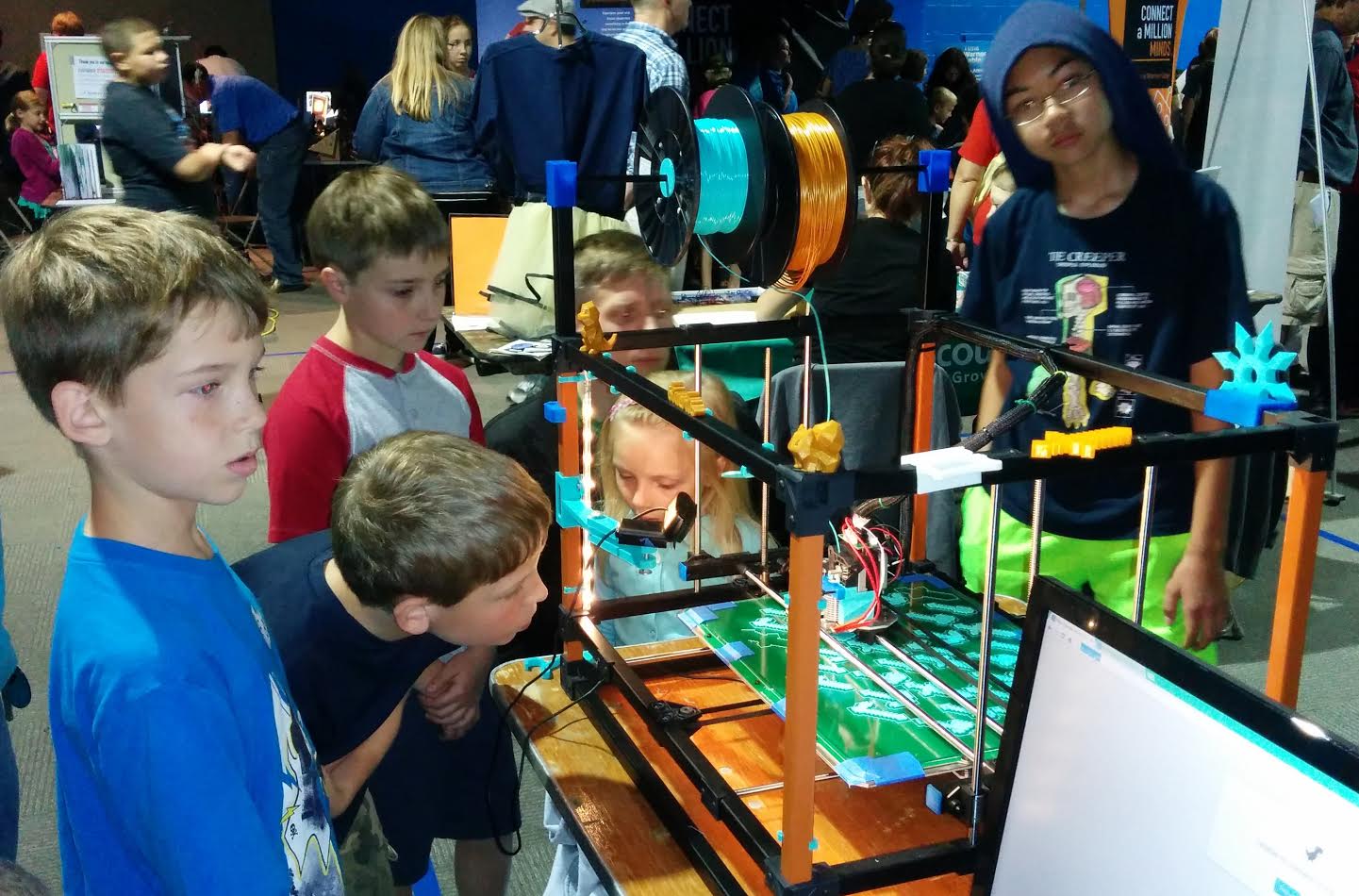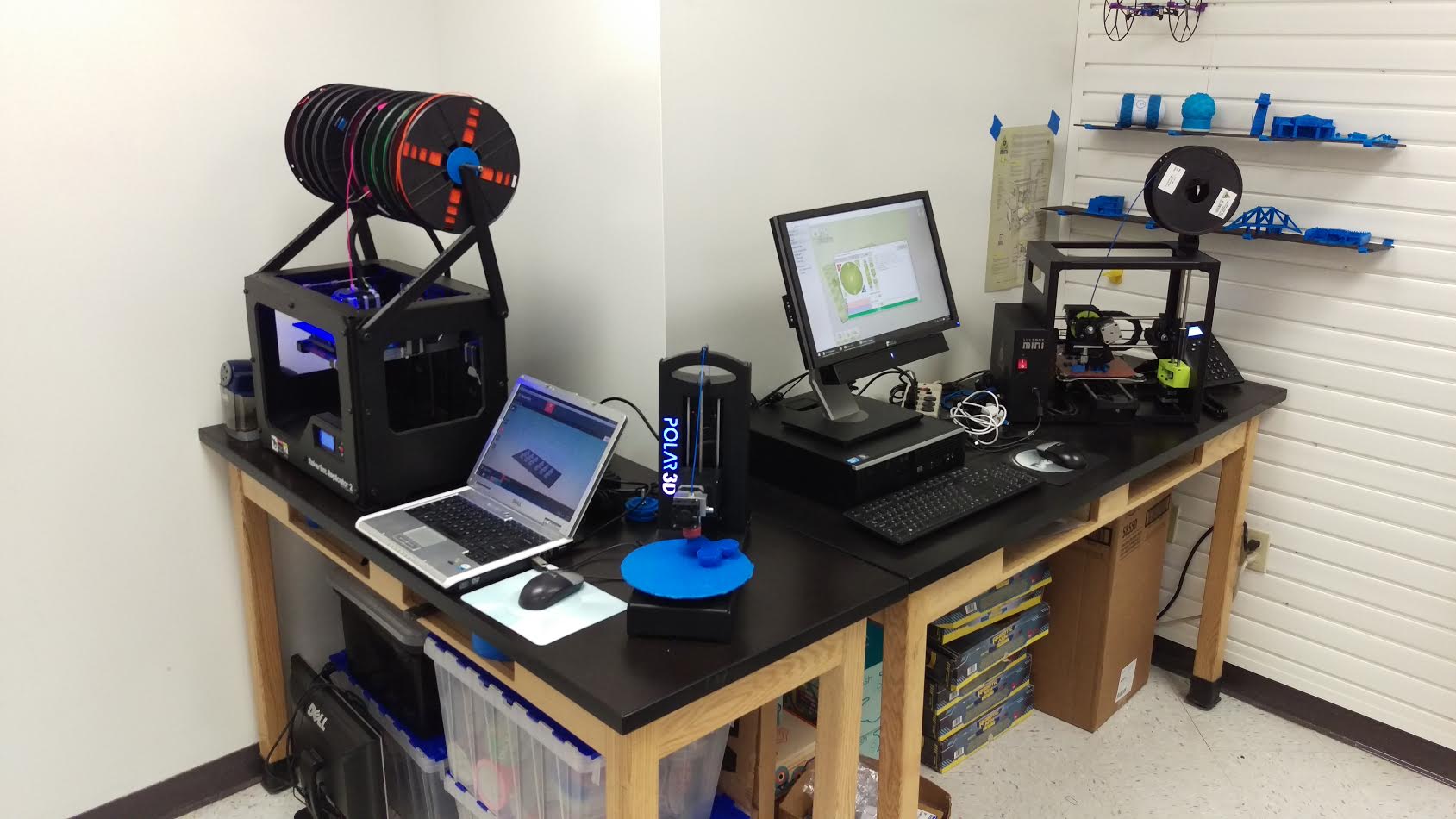At this point, you can apply a 3D printing strategy in nearly any vertical market. Companies are already demonstrating success in automotive, aerospace, medical, consumer products, engineering, construction, and many others. And we’re not just talking about prototyping anymore. Some large, global organizations are looking at how additive manufacturing can help them digitize entire production and supply chains.
So for the purposes of this article, let’s take a look at the four pillars of opportunity and apply them to a specific vertical. Based on the title, you’re probably guessing education. If so, you passed the test!
HARDWARE
This is one of the toughest entry points. They call it hardware because it’s hard! There are several steps in the product development lifecycle, from innovation and design, to testing, production, and release. You may have a great idea, but you’ve got to work all the way through until it’s sellable and scalable.
Once your product hits the market you can expect feedback. Sometimes it’s direct, but in other cases it’s via a third party. If you’re selling through a retail channel like Amazon for instance, customer reviews can be a great source of learning, but problems found there must be quickly addressed. Continuous improvement is vital. You must execute.
In the educational space there are all kinds of other hardware concerns and opportunities. I conducted research with a group of over 4,600 consumers and one of the things they thought was so exciting about 3D printing was “the ability to watch their products being made, either online or in-store.” Classrooms are no different. Anywhere there are kids and a 3D printer is running, you’ll find them pressed up against it, watching products materialize out of thin air.
 For this reason most elementary and high (el-hi) schools are taking a decentralized approach. They’re trying to put smaller printers in many classrooms. This can have unintended consequences. Organizations end up with assets littered across their domain, many in non-working condition.
For this reason most elementary and high (el-hi) schools are taking a decentralized approach. They’re trying to put smaller printers in many classrooms. This can have unintended consequences. Organizations end up with assets littered across their domain, many in non-working condition.
If history is any guide, I wouldn’t be surprised if schools begin to look at a more centralized approach. They’ll weigh the cost and risks of administering a large network of printers. Instead of printing in each class (and managing all the infrastructure that goes along with it) they’ll instead build larger 3D print labs that can handle the capacity of an entire building or even an entire district. As better technology makes that more feasible, it creates new threats and opportunities for the hardware manufacturers competing for those dollars.
MATERIALS
If you’re old like me, you might remember when schools used mimeograph machines to make copies. Handouts that were freshly printed gave off quite a smell (and maybe even a buzz?) but probably weren’t the best thing for a school environment.
Eventually they were replaced by photocopiers, which became less expensive and were arguably less hazardous.
As 3D printing continues to proliferate in schools, it also creates some potential safety hazards. The first is heat. If we’re talking FDM (and most printers in most schools are), you’ve got an extruder melting plastic at high temperatures.
The second safety issue relates to air quality. There have been studies which suggest that carcinogens and other ultrafine particles can be released into the environment when certain plastics are melted in 3D printers. Schools are becoming more aware of this and are starting to invest in enclosures that protect students from heat while filtering the fumes released during extrusion.
The two main materials for use in desktop 3D printers are both plastics. They have different attributes and usage requirements. Of the two, ABS is likely more harmful than PLA.
While it’s not a huge concern yet, companies that want to develop and sell 3D printable materials into educational environments can create a competitive advantage by minimizing toxicity.
From a desktop perspective, one which I think has significant potential is an algae-based filament made by Algix3D. It combines nuisance algae with PLA and according to its MSDS data sheet, releases 28 compounds into the air during printing, none of which were found to be toxic.
SOFTWARE
There are so many areas of opportunity with software. From how 3D models are created or sourced, to how they’re prepared for printing, there’s room for improvement. But beyond that, software can be used as part of the educational process, helping teachers create lesson plans and collaborate with their students.
One of the areas in which I’m particularly interested is workflow. As mentioned above, I think schools will soon take less of an ad hoc approach, becoming more sophisticated in how they manage the demand for 3D printing.
Just imagine 3D printing at scale in an educational environment. At a large school district you could have thousands of students participating. Just recently, in fact, I saw a public bid request from a school district that specified dozens of 3D printers spanning multiple different brands and print technologies.
At universities, students from art and industrial design, to engineering and physics (among other other majors) are already users. Some own a 3D printer, some print through university “fab labs” and some use outside sources.
Demand is often seasonal. In el-hi it might be spread across the school year, but in college it typically peaks at the end of a quarter or semester. If you’re printing on behalf of students, at some point you can no longer manage it with labor. You’d need software just to keep up.
Let’s face it, there still aren’t a lot of great off-the-shelf workflow solutions for 3D printing. Some software packages cover pieces and parts, but not many are comprehensive. Some schools have made the decision to create their own software, with varying results. Others are still managing the work manually and many of those have yet to even recognize the impending problem.
As I discussed in a previous article, there is a significant opportunity for Web to 3D Print (W23DP) software – both as a way to manage consumer orders and to manage requests from large groups of internal customers. In other related industries, these software solutions not only allow users to submit files, but also give them a way to provide the specifications necessary for cost calculation, which allows service bureaus to quote prices and take orders online.
SERVICES
To some degree software and services go hand-in-hand. If you’re going to offer content for example, you’ve got to have a way to deploy it. Content means different things to different people. In traditional classroom environments, that might mean a formal curriculum. Other settings, like after-school clubs and summer or day camps, might require a quicker, more compressed learning plan. It could also include tutorials on ancillary, but related, topics like CAD design. But, as mentioned above, content could also include a library of print-ready files. In any of those scenarios, users need a way to access and retrieve the necessary assets.
Services also include things like production. In a decentralized environment, it could be as simple as a print queue. But even there, a more holistic software solution could help administrators monitor an entire network of print devices. In a more centralized structure, software could help internal print shops manage the volume, allowing them to forecast and plan their labor, allocate machine time, and optimize their material and supply requisitions.
There’s lots of room in the educational market for outside firms. A third party service bureau could help a school district or university get into 3D printing without making a huge investment in capital. The school could use the service bureau’s software, and then once the volume hits critical mass, justify bringing their own equipment in house.
That happened frequently with digital (2D) printing. Course packets were a great example. They were custom books, created for specific college courses and printed in small batches, or sometimes on demand. In the early days many of them were printed at Kinko’s or at an off-campus bookstore. Then as the demand became obvious, universities began bringing production in-house. But even once that happened, there were still opportunities for third parties to compete or serve as an overflow to a school’s in-house efforts.
Electing to compete for volume can be a difficult choice – especially if you’re providing equipment, materials or software to your educational customers. They’ll naturally and rightfully assume that you can run your own equipment and supply your own facility with materials at a less expensive rate than you sell them to your customers. If you’re providing software, it could create a conflict of interest – especially when you know a customer’s internal cost as well as them.
In the educational market, there is clearly a place for all four pillars. The demand is already present and growing rapidly. From small private academies to large metropolitan school districts and from community colleges to some of the world’s largest universities, educators are recognizing the value of 3D printing and how it fits with other science, technology, engineering and math (STEM) initiatives.
The challenge for companies that are already in the space, and those contemplating an entry, is deciding which of the four to provide. That requires careful thought and deliberation. You need a detailed go-to market strategy. Once the decisions are made and your plan is in place, it’s all about execution.
[Creative Commons 3 x 3D = Awesomeness is Copyright © 2015 by Kevin Jarrett]
John Hauer is the Founder and CEO of Get3DSmart, a consulting practice which helps large companies understand and capitalize on opportunities with 3D printing. Prior to that, John co-Founded and served as the CEO of 3DLT. The company worked with retailers and their suppliers, helping them sell 3D printable products, online and in-store.
John’s original content has been featured on TechCrunch, QZ.com, Techfaster.com, 3DPrint.com and Inside3DP.com, among others. Follow him on Twitter at @Get3DJohn
Subscribe to Our Email Newsletter
Stay up-to-date on all the latest news from the 3D printing industry and receive information and offers from third party vendors.
You May Also Like
IperionX Inks 10-Year Deal with Wisconsin Manufacturer for 80 Metric Tons of Titanium Per Year
IperionX, the Charlotte-based supplier of sustainable titanium powders used for additive manufacturing (AM) and metal injection molding (MIM), has signed a ten-year deal with United Stars, a group of industrial...
Gastronology Launches Industrial Production of 3D Printed Food for Dysphagia Patients
Food 3D printing has, in many ways, been an additive manufacturing (AM) segment looking for the right business case. While some applications are beautiful and others may or may not...
Lockheed Martin Leads $3M Investment in Q5D’s Electronics 3D Printing System
Q5D, an original equipment manufacturer (OEM) of robotic arm, hybrid additive manufacturing (AM) systems used for wire harness production, has closed a $3 million investment round. The investment arm of...
3D Printing News Briefs, April 6, 2024: Depowdering, Cybertruck Door Handles, & More
In today’s 3D Printing News Briefs, ioTech’s digital manufacturing CLAD technology is opening up opportunities for microelectronics and additive manufacturing. Hexagon and Raytheon Technologies commercially released the Simufact Additive Process...
































